Five Factors That Affect Reaction Rates
The rate of a reaction is a very important consideration in chemistry, particularly when reactions have industrial importance. A reaction that seems useful but proceeds too slowly is not going to be helpful in terms of making a product. The conversion of diamond into graphite, for example, is favored by thermodynamics but thankfully proceeds almost imperceptibly. Conversely, reactions that move too quickly can sometimes become hazardous. Reaction rate is controlled by multiple factors, all of which can be varied under controlled conditions.
Temperature
Temperature
In almost very case, raising the temperature of chemicals increases the rate of their reaction. This reaction is due to a factor known as "activation energy." The activation energy for a reaction is the minimum energy two molecules need in order to collide together with enough force to react. As the temperature rises, molecules move more vigorously, and more of them have the required activation energy, increasing the rate of the reaction. A very rough rule of thumb is that the rate of a reaction doubles for every 10 degrees Celsius rise in temperature.
Concentration and Pressure
Concentration and Pressure
When chemical reactants are in the same state — both dissolved in a liquid, for example — the concentration of the reactants typically affects the reaction rate. Increasing the concentration of one or more reactants will normally increase the reaction rate to some degree, since there will be more molecules to react per unit time. The degree to which the reaction speeds up depends on the particular "order" of the reaction. In gas phase reactions, increasing the pressure will often raise the reaction rate in a similar manner.
Medium
Medium
The particular medium used to contain the reaction can sometimes have an effect on reaction rate. Many reactions take place in a solvent of some kind, and the solvent can increase or decrease the reaction rate, based on how the reaction occurs. You can speed up reactions that involve a charged intermediate species, for example, by using a highly polar solvent such as water, which stabilizes that species and promotes its formation and subsequent reaction.
Catalysts
Catalysts
Catalysts work to increase the rate of a reaction. A catalyst works by changing the normal physical mechanism of the reaction to a new process, which requires less activation energy. This means that at any given temperature, more molecules will possess that lower activation energy and will react. Catalysts accomplish this in a variety of ways, although one process is for the catalyst to act as a surface where chemical species are absorbed and held in a favorable position for subsequent reaction.
Surface Area
Surface Area
For reactions that involve one or more solid, bulk phase reactants, the exposed surface area of that solid phase can affect the rate. The effect normally seen is that the larger the surface area exposed, the faster the rate. This occurs because a bulk phase has no concentration as such, and so can only react at the exposed surface. An example would be the rusting, or oxidation, of an iron bar, which will proceed more quickly if more surface area of the bar is exposed.
References
Cite This Article
MLA
Judge, Michael. "Five Factors That Affect Reaction Rates" sciencing.com, https://www.sciencing.com/five-factors-affect-reaction-rates-8177861/. 24 April 2017.
APA
Judge, Michael. (2017, April 24). Five Factors That Affect Reaction Rates. sciencing.com. Retrieved from https://www.sciencing.com/five-factors-affect-reaction-rates-8177861/
Chicago
Judge, Michael. Five Factors That Affect Reaction Rates last modified March 24, 2022. https://www.sciencing.com/five-factors-affect-reaction-rates-8177861/
